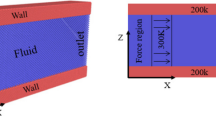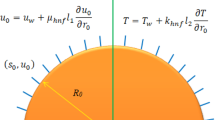Abstract
In this paper, the hybrid atomistic-continuum (HAC) method is used to investigate the properties of fluid flow inside a cavity on different surfaces. To extract the microscopic quantities of the flow on surfaces with different conditions (rough or smooth), a combination of Materials Studio 2017 and LAMMPS software and to extract the macroscopic results of the flow, OpenFOAM software has been used. In this paper, a strategy is used to reduce the thickness of atomic domain, which can reduce the time consuming associated with HAC solver by up to 17%. The interaction of argon gas with different surfaces of copper, iron, nickel, platinum, silicon, aluminum and amorphous polyethylene was also examined using the two mixing laws of Lorentz–Berthelot (LB) and Fender–Halsey (FH), and the effects of surface material and the type of mixing law on the formation of flow inside the cavity were investigated. Based on different simulations, it was shown that the FH mixing law can predict the potential energy more accurately than the LB mixing law. It was also shown that the TMAC increases by 4 and 3%, respectively, by creating the protrusions on the iron surface and creating the xenon coating on it.















Similar content being viewed by others
References
Yuanyuan L, Yuting L, Lanlan F, Gui L (2020) Metal alloy nanowire joining induced by femtosecond laser heating: a hybrid atomistic-continuum interpretation. Int J Heat Mass Transf 150:119287
Lu Y, Huang J, Wang S, Lou J (2010) Cold welding of ultrathin gold nanowires. Nat Nanotechnol 5:218–224
Valentín L, Betancourt J, Fonseca L, Huczko M (2013) A comprehensive study of thermoelectric and transport properties of β-silicon carbide nanowires. J Appl Phys 114:184301
Li J, Wang C, Peng H, Wang M, Zhang R (2010) Vibrational and thermal properties of small diameter silicon nanowires. Appl Phys 108:063702
Anderson T, Jackson R (1967) A fluid mechanical description of fluidized beds: equations of motion. Ind Chem Eng Fundam 6:527–534
O’Connell S, Thompson P (1995) Molecular dynamics-continuum hybrid computations: a tool for studying complex fluid flows. Phys Rev E 52(6):5792–5795
Nie X, Chen S, Robbins M (2004) A continuum and molecular dynamics hybrid method for micro- and nano-fluid flow. J Fluid Mech 500:55–64
Lin J, Chen S, Robbins M (2007) A continuum-atomistic simulation of heat transfer in micro- and nano-flows. J Comput Phys 227(1):279–291
Nie X, Chen S, Robbins M (2004) Hybrid continuum-atomistic simulation of singular corner flow. Phys Fluids 16(10):3579–3591
Hadjiconstantinou NG, Patera AT (1997) Heterogeneous atomistic-continuum representations for dense fluid systems. Int J Mod Phys C 8(4):967–976
Flekkøy E, Wagner G, Feder J (2000) Hybrid model for combined particle and continuum dynamics. Europhys Lett 52(3):271–279
Delgado-Buscalioni R, Coveney P (2003) Continuum-particle hybrid coupling for mass, momentum, and energy transfers in unsteady fluid flow. Phys Rev E 67(4):046704
Nie X, Robbins MO, Chen S (2006) Resolving singular forces in cavity flow: multiscale modeling from atomic to millimeter scales. Phys Rev Lett 96(13):134501
Werder T, Walther JH, Koumoutsakos P (2005) Hybrid atomistic-continuum method for the simulation of dense fluid flows. J Comput Phys 205(1):373–390
Kalweit M, Drikakis D (2008) Coupling strategies for hybrid molecular-continuum simulation methods. J Mech Eng Sci 222(5):797–806
Kalweit M, Drikakis D (2008) Multiscale methods for micro/nano flows and materials. J Comput Theor Nanosci 5(9):1923–1938
Zhou W, Luan H, He Y, Sun J, Tao W (2014) A study on boundary force model used in multiscale simulations with non-periodic boundary condition. Microfluid Nanofluid 16(3):587–595
Delgado-Buscalioni R, Flekkøy EG, Coveney PV (2005) Fluctuations and continuity in particle-continuumhybrid simulations of unsteady flows based on flux-exchange. Europhys Lett 69(6):959–965
Wang Q, Ren X-G, Xu X-H, Li C, Ji H-Y, Yang X-J (2017) Coupling strategies investigation of hybrid atomistic-continuum method based on state variable coupling. Adv Master Sci Eng 2017:1014636
Cosden IA, Lukes JR (2013) A hybrid atomistic–continuum model for fluid flow using LAMMPS and OpenFOAM. Comput Phys Commun 184:1958–1965
Hadjiconstantinou NG, Garcia AL, Bazant MZ, He G (2003) Statistical error in particle simulations of hydrodynamic phenomena. J Comput Phys 187(1):274–297
Delgado-Buscalioni R, Coveney P (2003) Usher: an algorithm for particle insertion in dense fluids. J Chem Phys 119(2):978–987
Thompson A, Troian S (1997) A general boundary condition for liquid flow at solid surfaces. Nature 389(6649):360–362
Schoch RB, Han J, Renaud P (2008) Transport phenomena in nanofluidics. Rev Mod Phys 80(3):839–883
Bian X, Deng M, Tang Y-H, Karniadakis GE (2016) Analysis of hydrodynamic fluctuations in heterogeneous adjacent multidomains in shear flow. Phys Rev E 93(3):033312
Ren X-G, Wang Q, Xu L-Y, Yang W-J, Xu X-H (2017) Hacpar: an efficient parallel multiscale framework for hybrid atomistic-continuum simulation at the micro- and nanoscale. Adv Mech Eng 9(8):1–13
Al-Matar A, Rockstraw D (2004) A generating equation for mixing rules and two new mixing rules for interatomic potential energy parameters. J Comput Chem 25(5):660–668
Sha H, Faller R, Tetiker G, Woytowitz P (2018) Molecular simulation study of aluminum-noble gas interfacial thermal accommodation coefficients. AIChE J 64(1):338–345
Kamara KK, Kumar R (2020) Development of empirical relationships for surface accommodation coefficients through investigation of nano-poiseuille flows using molesular dynamicd method. Microfluid Nanofluid 24(9):1–14
Klemens PG, Williams RK (1986) Thermal conductivity of metals and alloys. Int Met Rev 31(1):197–215
Yen TH, Soong CY, Tzeng PY (2007) Hybrid molecular dynamics-continuum simulation for nano/mesoscale channel flows. Microfluid Nanofluid 3(6):665–675
Marcantoni LFG, Tamagno JP, Elaskar SA (2012) High speed flow simulation using openFOAM. Mecan Comput 31(16):2939–2959
Issa R (1985) Solution of the implicity discretised fluid flow equations by operator-splitting. J Comput Phys 62(1):40–65
Tysanner MW, Garcia AL (2004) Measurement bias of fluid velocity in molecular simulations. J Comput Phys 196(1):173–183
Wang Q, Ren XG, Xu XH, Li C, Ji HY, Yang XJ (2017) Coupling strategies investigation of hybrid atomistic-continuum method based on state variable coupling. Adv Mater Sci Eng 2017:1–21
Mao Y, Zhang Y, Chen CL (2015) Atomistic-continuum hybrid simulation of heat transfer between argon flow and copper plates. J Heat Transfer 137(9):091011
Sun J, He Y-L, Tao W-Q (2010) Scale effect on flow and thermal boundaries in micro-/nano-channel flow using molecular dynamics-continuum hybrid simulation method. Int J Numer Methods Eng 81(2):207–228
Ko S-H, Kim N, Nikitopoulos DE, Moldovan D, Jha S (2010) Parametric study of a multiscale fluidic system using a hybrid CFD-MD approach. In: Proceedings of the 5th European conference on computational fluid dynamics (ECCOMAS CFD ’10)
Delgado-Buscalioni R, Coveney PV (2004) Hybrid molecular-continuum fluid dynamics. Philos Trans R Soc Lond Ser A: Math, Phys Eng Sci 362(1821):1639–1654
Wang YC, He GW (2007) A dynamic coupling model for hybrid atomistic-continuum computations. Chem Eng Sci 62(13):3574–3579
Asproulis N, Drikakis D (2013) An artificial neural network-based multiscale method for hybrid atomistic-continuum simulations. Microfluid Nanofluid 15:559–574
Zhou WJ, Yu ZQ, Li ZZ, Wei J, Tao W (2017) Atomistic-continuum hybrid simulations for compressible gas flow in a parallel nanochannel. Int J Heat Mass Transf 108:2100–2106
Daun KJ, Sipkens TA, Titantah JT, Karttunen M (2013) Thermal accommodation coefficients for laser-induced incandescence sizing of metal nanoparticles in monatomic gases. Appl Phys B 112(3):409–420
Daun KJ, Karttunen M, Titantah JT (2011) Molecular dynamics simulation of thermal accommodation coefficients for laser-induced incandescence sizing of Nickle nanoparticles. ASME Int Mech Eng Congr Expos 54976:307–315
Yousefi-Nasab S, Safdari J, Karimi-Sabet J, Mallah MH (2021) Molecular dynamics simulations on the scattering of heavy gases on the composite surfaces. Vacuum 183:109864
Yousefi-Nasa S, Safdari J, Karimi-Sabet J, Norouzi A, Amini E (2019) Determination of momentum accommodation coefficients and velocity distribution function for noble gas-polymeric surface interactions using molecular dynamics simulation. Appl Surf Sci 493:766–778
Sun H, Liu Z, Xin Q, Zhang J, Cao BY (2020) Thermal and flow characterization in nanochannels with tunable surface wettability: a comprehensive molecular dynamics study. Numer Heat Transf, Part A: Appl 78(6):1–20
Prabha SK, Sathian SP (2012) Molecular dynamics study of Poiseuille flow in a nanochannel and calculation of energy and momentum accommodation coefficients. Phys Rev E 85(4):041201
Cagin T, Qi Y, Li H, Kimura Y, Ikeda H (1999) Molecular dynamics simulation of supercooled liquid metals. MRS Ser 554:43
Maghfiroh CY, Arkundato A, Maulina W (2020) Parameters (σ, ε) of Lennard-Jones for Fe, Ni, Pb for potential and Cr based on melting point values using the molecular dynamics method of the Lammps program. J Phys Confer Ser 1491(1):012022
Stillinger FH, Weber TA (1985) Computer simulation of local order in condensed phases of silicon. Phys Rev B 31(8):5262
Bhadauria R, Aluru NR (2013) A quasi-continuum hydrodynamic model for slit shaped nanochannel flow. J Chem Phys 139(7):074109
Mane T, Bhat P, Yang V (2018) Energy accommodation under non-equi;ibrium conditions for aluminum-inert gas systems. Surf Sci 677:135–148
Puri P, Yang V (2007) Effect of particle size on melting of aluminum at nano scales. J Phys Chem C 111(32):11776–11783
Karasawa N, Dasgupta S, Goddard WA (1991) Mechanical properties and force field parameters for polyethylene crystal. J Phys Chem 95(6):2260–2272
Hossain D, Tschopp M, Ward DK, Bouvard JL, Wang P (2010) Molecular dynamics simulations of deformation mechanisms of amorphous polyethylene. Polymer 51(25):6071–6083
Gronych T, Ulman R, Peksa L, Řepa P (2004) Measurements of the relative momentum accommodation coefficient for different gases with a viscosity vacuum gauge. Vacuum 73(2):275–279
Tekasakul P, Bentz JA, Tompson RV, Loyalka SK (1996) The spinning rotor gauge: Measurements of viscosity, velocity slip coefficients, and tangential momentum accommodation coefficients. J Vac Sci Technol, A: Vac, Surf Films 14(5):2946–2952
Acharya T, Falgoust J, Schoegl I, Martin MJ (2019) Measurement of Variation of Momentum Accommodation Coefficients with Molecular Mass and Structure. J Thermophys Heat Transfer 33(3):773–778
Nedea SV, van Steenhoven AA, Markvoort AJ, Spijker P, Giordano D (2014) Gas-surface interactions using accommodation coefficients for a dilute and a dense gas in a micro-or nanochannel: Heat flux predictions using combined molecular dynamics and Monte Carlo techniques. Phys Rev E 89(5):053012
Hemadri V, Agrawal A, Bhandarkar UV (2018) Determination of tangential momentum accommodation coefficient and slip coefficients for rarefied gas flow in a microchannel. Sādhanā 43(10):1–7
Ewart T, Perrier P, Graur I, Méolans JG (2007) Tangential momemtum accommodation in microtube. Microfluid Nanofluid 3(6):689–695
Acharya T, Falgoust J, Martin MJ, Rasmussen RE (2015) Measurement of continuum breakdown during disk spindown in low-pressure air. J Thermophys Heat Transfer 29(2):281–290
Selden N, Gimelshein N, Gimelshein S, Ketsdever A (2009) Analysis of accommodation coefficients of noble gases on aluminum surface with an experimental/computational method. Phys Fluids 21(7):073101
Trott WM, Castañeda JN, Torczynski JR, Gallis MA, Rader DJ (2011) An experimental assembly for precise measurement of thermal accommodation coefficients. Rev Sci Instrum 82(3):035120
Acknowledgements
This work was supported financially by the Nuclear Fuel Cycle Research School at Atomic Energy Organization of Iran, P.O. Box: 1439955931.
Funding
There are no funding sources for this manuscript.
Author information
Authors and Affiliations
Corresponding author
Ethics declarations
Conflict of interest
The authors declare that they have no conflict of interest.
Additional information
Publisher's Note
Springer Nature remains neutral with regard to jurisdictional claims in published maps and institutional affiliations.
Rights and permissions
Springer Nature or its licensor holds exclusive rights to this article under a publishing agreement with the author(s) or other rightsholder(s); author self-archiving of the accepted manuscript version of this article is solely governed by the terms of such publishing agreement and applicable law.
About this article
Cite this article
Yousefi-Nasab, S., Karimi-Sabet, J. & Safdari, J. Investigation of the effect of wall material on the exchange of information between fluid and surface using the hybrid atomistic-continuum method. Comp. Part. Mech. 10, 565–584 (2023). https://doi.org/10.1007/s40571-022-00512-7
Received:
Revised:
Accepted:
Published:
Issue Date:
DOI: https://doi.org/10.1007/s40571-022-00512-7




